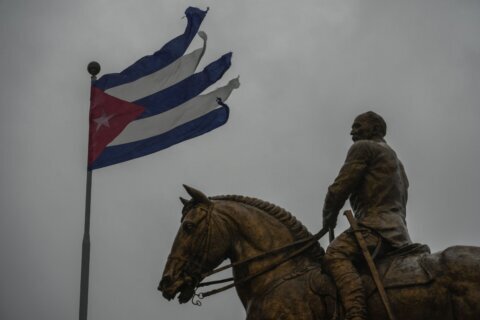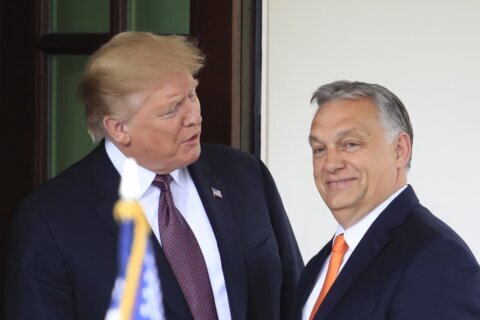NEW DELHI — An intensifying protest by farmers in India is turning into the biggest test that Narendra Modi has faced since he became prime minister in 2014.
Tens of thousands of farmers, mainly from the northern states of Punjab and Haryana, have been camping at highways and other major entry points to Delhi since late November. They are demanding the repeal of three farm reform laws that the Modi government passed in September.
The government has held several rounds of talks with the farmers, with little progress. Meanwhile, the farmers are digging in their heels, staying at outdoor campsites even as the weather turns cooler, with temperatures dipping to 40 degrees Fahrenheit at night.
“We are ready to bear the cold; we don’t want to bear these laws,” says Rajinder Singh Deep Singh Wala, vice president of the Kirti Kisan Union, one of several farmer unions that are protesting. Deep Singh Wala says he has been stationed at the Singhu border between Delhi and Haryana since Nov 26.
Farmers have parked their tractor trolleys and other vehicles for several miles along the roads, disrupting the movement of people and goods to and from Delhi. Protesters sleep in their trolleys, or in tent cities that have been set up at the protest sites. Volunteers have set up community kitchens to serve food, provide blankets and warm clothing, to provide free laundry service to protesters, and to even give away turbans, a hallmark of the Sikh people, who are the face of the protests.
Analysts say the government is treading carefully in negotiations because agriculture is a sensitive subject. More than half of India’s 1.3 billion people are tied to the sector.
“These things can snowball, given that India is still largely rural and most Indians can therefore relate to and empathize with the agitators,” says Sumantra Bose, professor of international and comparative politics at the London School of Economics.
Farmers are upset about three new laws that seek to open up the production and sale of agricultural produce, which they say is a way to give more control to agricultural companies.
The laws dismantle a system in which farmers sell their crops through “mandis,” the Hindi word for wholesale markets. The mandis are approved by the government and allow farmers to sell their produce directly to consumers or agri-businesses. These wholesale markets are dominated by middlemen, and experts agree that the existing system is riddled with inefficiencies.
[MORE: Women Take Prominent Role in India’s Protests]
While this older system allows farmers to directly sell their produce, they have preferred to sell it through the wholesale markets because that produce was bought by the government, which paid a “minimum support price” that is higher than the open-market price. Protesters say the new laws are meant to favor large companies, and to get rid of the minimum support price.
The government has said that the minimum support price will not be disbanded, and that the new laws will help raise farmer incomes. “This legislation will act as a catalyst to attract private sector investment for building supply chains for supply of Indian farm produce to national and global markets,” according to a government statement. Modi has accused opposition parties of spreading misinformation.
“We are fighting a farmer agitation, not a political one,” says Deep Singh Wala, the union leader.
The protests are gaining intensity, with leaders earlier this week starting a “relay hunger strike,” with farmers from other parts of the country joining in.
A contingent of farmers from the western state of Maharashtra have set out by road to reach Delhi, roughly the same as the distance between New York City and Chicago. Indian-Americans have also held protests in several cities in the United States and in Canada to support the farmer protests in India.
Some youth within the farmer groups have taken to social media pages to share their message directly with the public.
“They are not only fighting the policy, they’re also fighting the government propaganda,” says Sarthak Bagchi, a professor of Indian politics at Ahmedabad University. “The government is grasping for a grip on the narrative.”
A YouTube channel created on Dec. 16, has surpassed 1 million subscribers. Recent videos show protest events, including people participating in hunger strikes, chanting devotional songs and making speeches.
Political analysts note that this time the Modi government is taking a less aggressive stance against protesters than it has in the past. A year ago, when students took to the streets against new citizenship laws, police had used force and loaded protesters into buses to detain them. In the farmer protests, police used water cannons and tear gas on protesters in late November to prevent them from entering Delhi, but have since avoided such tactics.
This softer stance is a sign of the challenge the government faces, says Ajay Gudavarthy, a professor at the Centre for Political Studies at Jawaharlal Nehru University in New Delhi.
“They’re facing a legitimacy crisis,” Gudavarthy says, adding that the prime minister can neither be seen to directly go against the farmers or withdraw the bill. Modi has built an image of an aggressive, brazen politician who gets things done, Gudavarthy says. If he agrees to withdraw the bills, “that infallible image” will take a beating. “It will be interesting to wait and see how he will come out of this.”
Yet some analysts say the farmer protests will have no significant impact on the Modi government’s standing. “If it would have been an election year, then it would have been a different story,” says Prakash Singh, a political science professor at the University of Delhi.
Critics have expressed concern about the speed with which these farm laws were passed, without adequate scrutiny in Parliament. With Modi’s Bharatiya Janata Party in absolute majority in the lower house of Parliament, this was easy to do.
Meanwhile, opposition parties have been weak and fragmented, and unable to present an alternate voice.
Last winter’s citizenship protests and today’s farmer protests are both expressions of many people believing they are not represented as laws are being crafted, says Bose of the London School of Economics. “It shows that the parliamentary system in India is in really bad shape, that’s why protesters are coming to the streets.”
More from U.S. News
Across India, a Balance to Reclaim Normal Lives Amid Coronavirus Pandemic
Informal Female Workers Face Harassment and Abuse in India, Report Finds
The 25 Best Countries in the World
Farmer Protests Pose Biggest Test for Modi Government originally appeared on usnews.com







